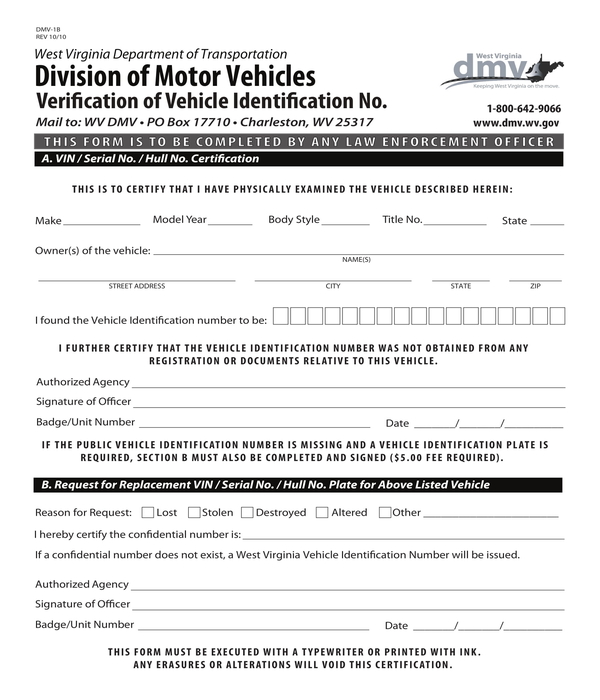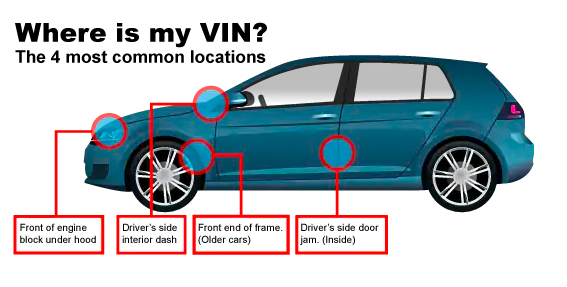Enter the number of the car that you would like to check in the corresponding field. Hit the Check VIN button. Voila, a comprehensive history report on the vehicle of your choice will be given to you in a couple of minutes. All you need to do is to examine it. First used in 1954 in the United States, the vehicle identification number is the unique code adopted by car manufacturers to identify motor vehicles, motorcycles, towed vehicles, scooters, and mopeds. Until the early 1980s, the automotive industry used different serial numbers, with no commonly agreed standard. A VIN, or “Vehicle Identification Number,” acts as the serial number for the purpose of certifying that a car has not been stolen upon registration. Depending on the State, this form is either filled in as an oath from the registrant or it is signed and verified by an approved third (3rd) party. Enter your vehicle’s 17-character Vehicle Identification Number (VIN) in the field above to look up and receive an instant report on the year, make model, and body style of the vehicle. The VIN will also reveal details such as the engine size and even where it was built. All information is verified and pulled from National Highway Traffic Safety Administration database. The database decodes only VINS that are 17 characters from 1982 and on. The Anatomy of a Vin Number. How is it Decoded.
- Motor Vehicle Identification Number Verification Florida
- Vehicle Serial Number Lookup Canada
- Old Vehicle Serial Number Lookup
- Vehicle Serial Number Verification
The VIN verification form is required for out-of-state motor vehicles when registering in applicable States. A VIN, or “Vehicle Identification Number,” acts as the serial number for the purpose of certifying that a car has not been stolen upon registration. Depending on the State, this form is either filled in as an oath from the registrant or it is signed and verified by an approved third (3rd) party.
- California – Form REG-31
- Colorado – Form DR 2698
- Connecticut – Form AE-81
- Florida – Form HSMV 82042
- Idaho – Form ITD 3403
- Indiana – Form 39530
- Kansas – Form TR-65
- Kentucky – Form TC 96‐229
- Maine – Form MVT-10
- Nevada – Form VP15
- New Mexico – Form MVD-10705
- Oklahoma – Form 701-6
- Oregon – Form 735-11
- Pennsylvania – Form MV-41
- Rhode Island – VIN Check Form
- Vermont – Form VT-010
- Washington – Visit Inspection Station
- Wyoming – Form MV-300A
Step 1 – It is best to use the State provided forms, although most DMV offices will allow for the standard template to be used. If you would like to use our standard template, download the form in either Adobe PDF, Microsoft Word (.docx), or Open Document Text (.odt).
Step 2 – The form is to be completed and signed by an authorized third (3rd) party before being returned to the owner. The third (3rd) party individual must begin by entering the State in which the vehicle is registered.
Step 3 – Next, the third (3rd) party must specify the following details in the spaces provided:
- Current date
- Vehicle year
- Vehicle make
- Vehicle model
- Vehicle Identification Number (VIN)
Motor Vehicle Identification Number Verification Florida
Step 4 – Finally, the third (3rd) party must provide their signature, printed name, and describe their position/title.
What is a VIN or Vehicle Identification Number?
VIN stands for “vehicle identification number,” and it is the unique code assigned by manufacturers for a specific automobile. A VIN is the automotive equivalent of a social security number; no two vehicles in operation have the same VIN.Where Can I Locate a Car’s VIN?
The VIN is most commonly located on the dashboard on the driver’s side of the vehicle. It can be viewed by standing outside the car and looking on the corner of the dashboard where it meets the windshield. If the VIN cannot be found there, it can be found by opening the driver’s side door and looking inside the door jamb. A VIN is also included on a vehicle’s registration, vehicle title, and insurance card.Decoding the Characters of a VIN:
Since 1981, the National Highway Traffic Safety Administration (NHTSA) standardized how VINs were assigned. Under the NHTSA standard, a VIN is composed of 17 characters (consisting of numbers and letters) with each set of numbers having a specific meaning. A VIN will never include the letters I, O, and Q to avoid being mistaken for 1 and 0.VIN Decoder:
VIN Digits - How to Decode a VIN Number:
There are 17 digits or characters that together comprise each vehicle’s unique VIN. Here is what each digit represents to help you better understand your motor vehicle.Digit 1: Country of Origin
The first digit specifies where the vehicle was manufactured. Here are the most common country codes and their corresponding countries:
1:United States
2: Canada
3: Mexico
4: Foreign vehicle made in the USA
9: Brazil
J: Japan
W: Germany
S: England
L: Taiwan
K: Korea
Y: Sweden
V: Europe
Z: Italy
Digits 2-3: Manufacturer and Division
The second digit identifies the specific vehicle’s manufacturer, which is often the first letter of the manufacturer’s name, such as ‘B’ for BMW vehicles. Some common examples include:
A: Audi
B: BMW
C: Chrysler
F: Ford
G: General Motors (Chevrolet, GMC, Cadillac, Buick)
H: Honda
L: Lincoln

N:Nissan
V: Volkswagen
However, some characters can stand for multiple manufacturers, so the third digit combines with the first two to indicate the specific manufacturing division. For example, JM1 can designate Mazda, while JMB can designate Mitsubishi. The first three digits together are known as the World Manufacturer Identifier (WMI).
Digits 4-8: Vehicle Descriptor Section (VDS)
Characters 4 through 8 identify the specific details about the car’s vehicle type.
- Digit 4: Safety features and information specific to the model
- Digit 5: The vehicle’s series
- Digits 6 and 7: Bodystyle and body type
- Digit 8: Engine size
-Step-3-Version-2.jpg/v4-460px-Find-Your-VIN-(Vehicle-Identification-Number)-Step-3-Version-2.jpg.webp)
The ninth digit is used to detect incorrect VINs based on a mathematical formula from the Department of Transportation.
Digit 10: Model Year
The tenth digit represents the vehicle’s model year. The letters B through Y designate model years 1981 to 2000, with the letters I, O, Q, U, Z excluded. The numbers 1 through 9 indicate the model years 2001 through 2009. In 2010, the alphabet cycles through again beginning with A and will last through the year 2030. Then numbers 1 through 9 will cycle through until 2039.
model years 2001 through 2009. In 2010, the alphabet cycles through again beginning with A and will last through the year 2030. Then numbers 1 through 9 will cycle through until 2039.| Code | Model Year | Code | Model Year | Code | Model Year |
| A | 1980 | X | 1999 | J | 2018 |
| B | 1981 | Y | 2000 | K | 2019 |
| C | 1982 | 1 | 2001 | L | 2020 |
| D | 1983 | 2 | 2002 | M | 2021 |
| E | 1984 | 3 | 2003 | N | 2022 |
| F | 1985 | 4 | 2004 | P | 2023 |
| G | 1986 | 5 | 2005 | R | 2024 |
| H | 1987 | 6 | 2006 | S | 2025 |
| J | 1988 | 7 | 2007 | T | 2026 |
| K | 1989 | 8 | 2008 | V | 2027 |
| L | 1990 | 9 | 2009 | W | 2028 |
| M | 1991 | A | 2010 | X | 2029 |
| N | 1992 | B | 2011 | Y | 2030 |
| P | 1993 | C | 2012 | 1 | 2031 |
| R | 1994 | D | 2013 | 2 | 2032 |
| S | 1995 | E | 2014 | 3 | 2033 |
| T | 1996 | F | 2015 | 4 | 2034 |
| V | 1997 | G | 2016 | 5 | 2035 |
| W | 1998 | H | 2017 | 6 | 2036 |
The eleventh digit indicates the vehicle’s assembly plant. Each vehicle manufacturer has its own set of plant codes.
For example, a Toyota VIN will have a numeric character or D, K, or J if it was manufactured at one of the automaker’s Japanese plants. R stands for its Lafayette, Indiana plant; S stands for Princeton, Indiana; and U designates Georgetown, Kentucky. These are just some of many of Toyota’s manufacturing plants.
Vehicle Serial Number Lookup Canada
Digits 12-17: Production Sequence Numbers

These final digits are the production line numbers which represent the vehicle’s unique serial number.

Digits 10-17 are collectively known as the Vehicle Identifier Section (VIS).
Are Free Vehicle History Reports Included in the iSeeCars VIN Report?
Old Vehicle Serial Number Lookup
Some iSeeCars VIN reports link to free vehicle history reports such as CARFAX or AutoCheck that provide critical information about a vehicle’s past: including if its been in an accident, its number of previous owners, and if it has a salvage title. By getting a free vehicle history report by VIN, consumers will better understand the condition of the vehicle and will be able to better anticipate future problems.Does a VIN Check Include Safety Recalls and Recall Information?
Yes. The iSeeCars VIN Lookup tool includes a Free Recall Check that links to the NHTSA database that will identify if there is an open recall. It also includes information about all past recalls that affected the vehicle. This can include safety-related recalls such as those involving Takata airbags. Along with being a safety hazard, unresolved recalls including emissions recalls can result in a failed vehicle inspection. If a vehicle has an open recall, ask the dealership to address the recall notice which will likely involve recall repairs.Vehicle Serial Number Verification
How Do I Run a VIN Lookup to Get the Free iSeeCars VIN Report?
The report can be accessed via the iSeeCars VIN Report app, available for iOS and Android, which allows users to instantly view the comprehensive report after scanning the vehicle’s VIN barcode. (If the VIN located on the windshield does not have a barcode, check the VIN located inside the driver’s side door.) Users get 10 free lookups to access 10 full reports. Paid subscription plans are also available for high-volume users. It can also be viewed by entering a VIN number at http://www.iseecars.com/vin, by clicking the “Full Report” button on all used car listings on iSeeCars.com, or via the Google Chrome extension, which automatically generates an iSeeCars VIN Report for each VIN it detects on any website such as Craigslist, Cargurus, Autotrader, Cars.com where you’re browsing a car.